Intel Pentium 4 6xx and 3.73EE: Favoring Features Over Performance
by Anand Lal Shimpi & Derek Wilson on February 21, 2005 6:15 AM EST- Posted in
- CPUs
Workstation Applications
Visual Studio 6
Carried over from our previous CPU reviews, we continue to use Visual Studio 6 for a quick compile test. We are still using the Quake 3 source code as our test and measure compile time in seconds. The results are pretty much in line with what we've seen in the past.
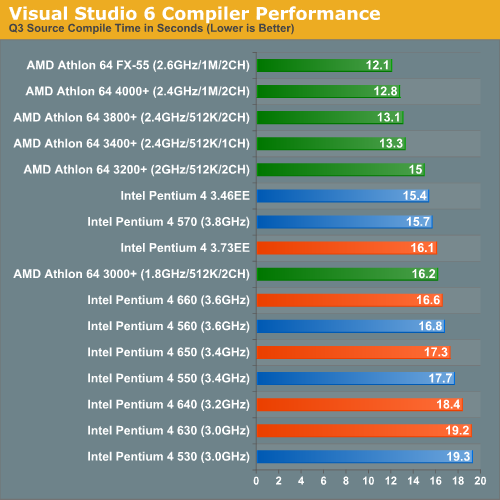
SPECviewperf 8
For our next set of professional application benchmarks we turn to SPECviewperf 8. SPECviewperf is a collection of application traces taken from some of the most popular professional applications, and compiled together in a single set of benchmarks used to estimate performance in the various applications the benchmark is used to model. With version 8, SPEC has significantly improved the quality of the benchmark, making it even more of a real world indicator of performance.
We have included SPEC's official description of each one of the 8 tests in the suite.
3dsmax Viewset (3dsmax-03)
"The 3dsmax-03 viewset was created from traces of the graphics workload generated by 3ds max 3.1. To insure a common comparison point, the OpenGL plug-in driver from Discreet was used during tracing.
The models for this viewset came from the SPECapc 3ds max 3.1 benchmark. Each model was measured with two different lighting models to reflect a range of potential 3ds max users. The high-complexity model uses five to seven positional lights as defined by the SPECapc benchmark and reflects how a high-end user would work with 3ds max. The medium-complexity lighting models uses two positional lights, a more common lighting environment.
The viewset is based on a trace of the running application and includes all the state changes found during normal 3ds max operation. Immediate-mode OpenGL calls are used to transfer data to the graphics subsystem."
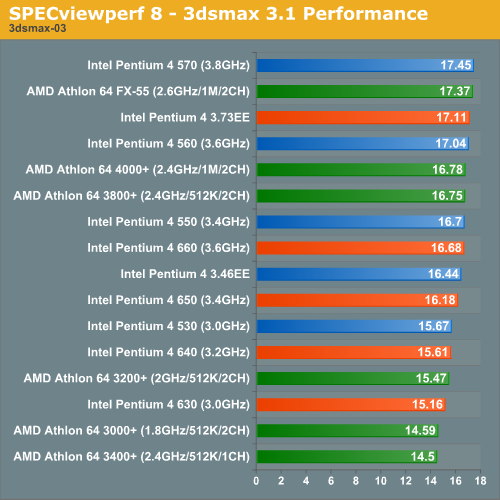
CATIA Viewset (catia-01)
"The catia-01 viewset was created from traces of the graphics workload generated by the CATIATM V5R12 application from Dassault Systems.
Three models are measured using various modes in CATIA. Phil Harris of LionHeart Solutions, developer of CATBench2003, supplied SPEC/GPC with the models used to measure the CATIA application. The models are courtesy of CATBench2003 and CATIA Community.The car model contains more than two million points. SPECviewperf replicates the geometry represented by the smaller engine block and submarine models to increase complexity and decrease frame rates. After replication, these models contain 1.2 million vertices (engine block) and 1.8 million vertices (submarine).
State changes as made by the application are included throughout the rendering of the model, including matrix, material, light and line-stipple changes. All state changes are derived from a trace of the running application. The state changes put considerably more stress on graphics subsystems than the simple geometry dumps found in older SPECviewperf viewsets.
Mirroring the application, draw arrays are used for some tests and immediate mode used for others."
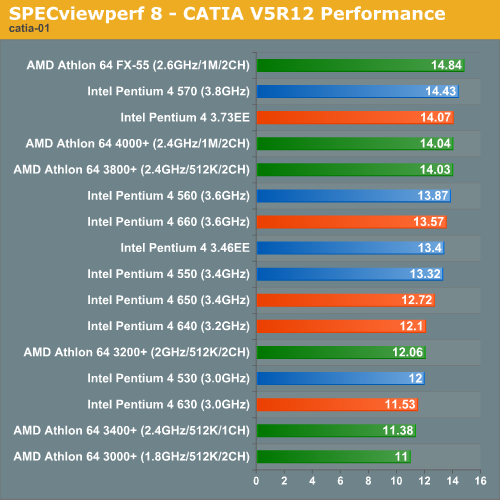
Lightscape Viewset (light-07)
"The light-07 viewset was created from traces of the graphics workload generated by the Lightscape Visualization System from Discreet Logic. Lightscape combines proprietary radiosity algorithms with a physically based lighting interface.
The most significant feature of Lightscape is its ability to accurately simulate global illumination effects by precalculating the diffuse energy distribution in an environment and storing the lighting distribution as part of the 3D model. The resulting lighting "mesh" can then be rapidly displayed."
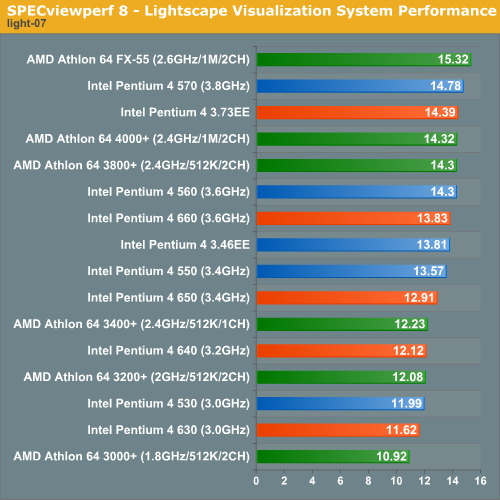
Maya Viewset (maya-01)
"The maya-01 viewset was created from traces of the graphics workload generated by the Maya V5 application from Alias.
The models used in the tests were contributed by artists at NVIDIA. Various modes in the Maya application are measured.
State changes as made by the application are included throughout the rendering of the model, including matrix, material, light and line-stipple changes. All state changes are derived from a trace of the running application. The state changes put considerably more stress on graphics subsystems than the simple geometry dumps found in older viewsets.
As in the Maya V5 application, array element is used to transfer data through the OpenGL API."
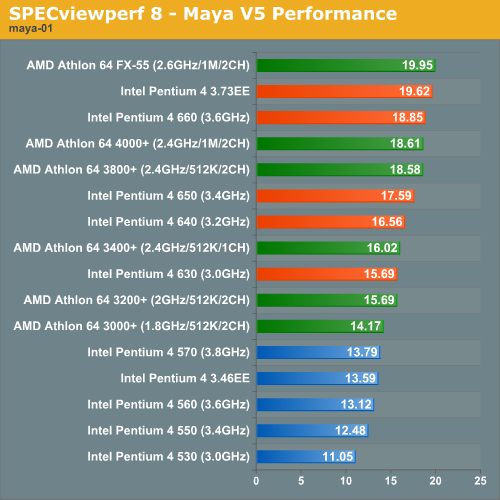
Pro/ENGINEER (proe-03)
"The proe-03 viewset was created from traces of the graphics workload generated by the Pro/ENGINEER 2001TM application from PTC.
Two models and three rendering modes are measured during the test. PTC contributed the models to SPEC for use in measurement of the Pro/ENGINEER application. The first of the models, the PTC World Car, represents a large-model workload composed of 3.9 to 5.9 million vertices. This model is measured in shaded, hidden-line removal, and wireframe modes. The wireframe workloads are measured both in normal and antialiased mode. The second model is a copier. It is a medium-sized model made up of 485,000 to 1.6 million vertices. Shaded and hidden-line-removal modes were measured for this model.
This viewset includes state changes as made by the application throughout the rendering of the model, including matrix, material, light and line-stipple changes. The PTC World Car shaded frames include more than 100MB of state and vertex information per frame. All state changes are derived from a trace of the running application. The state changes put considerably more stress on graphics subsystems than the simple geometry dumps found in older viewsets.
Mirroring the application, draw arrays are used for the shaded tests and immediate mode is used for the wireframe. The gradient background used by the Pro/E application is also included to better model the application workload."
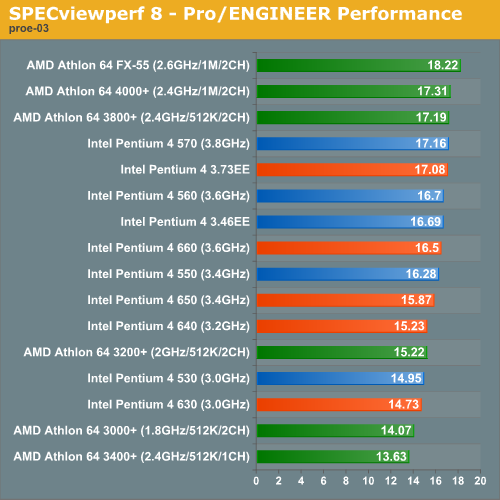
SolidWorks Viewset (sw-01)
"The sw-01 viewset was created from traces of the graphics workload generated by the Solidworks 2004 application from Dassault Systemes.
The model and workloads used were contributed by Solidworks as part of the SPECapc for SolidWorks 2004 benchmark.
State changes as made by the application are included throughout the rendering of the model, including matrix, material, light and line-stipple changes. All state changes are derived from a trace of the running application. The state changes put considerably more stress on graphics subsystems than the simple geometry dumps found in older viewsets.
Mirroring the application, draw arrays are used for some tests and immediate mode used for others."
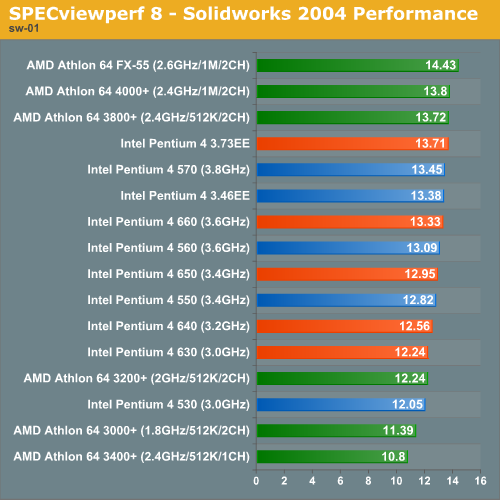
Unigraphics (ugs-04)
"The ugs-04 viewset was created from traces of the graphics workload generated by Unigraphics V17.
The engine model used was taken from the SPECapc for Unigraphics V17 application benchmark. Three rendering modes are measured -- shaded, shaded with transparency, and wireframe. The wireframe workloads are measured both in normal and anti-alised mode. All tests are repeated twice, rotating once in the center of the screen and then moving about the frame to measure clipping performance.
The viewset is based on a trace of the running application and includes all the state changes found during normal Unigraphics operation. As with the application, OpenGL display lists are used to transfer data to the graphics subsystem. Thousands of display lists of varying sizes go into generating each frame of the model.
To increase model size and complexity, SPECviewperf 8.0 replicates the model two times more than the previous ugs-03 test."
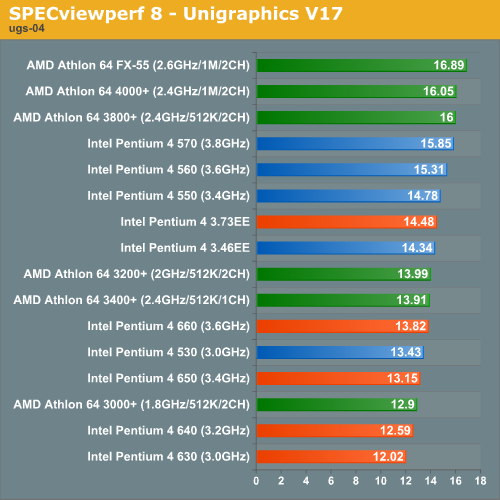










71 Comments
View All Comments
KingofL337 - Tuesday, February 22, 2005 - link
Why would anyone buy a P4 for EMT64? When AMD64 isa full implementations of 64 not just a poor incomplete copy?
In Soviet Russia, Computer Reboot You!
Zebo - Tuesday, February 22, 2005 - link
"The original Prescott was a Sunday launch. "Well see what I mean..:)
Hans Maulwurf - Tuesday, February 22, 2005 - link
And remember hyperthreading - it uses only a small area on the die and increases power consumption significantly!Oh, and I would still like to know weather it ws 1T or 2T on the Athlon.
Viditor - Tuesday, February 22, 2005 - link
Reflex - First, you may very well be quite correct!Second, not all parts of the die are equal...for example, the ALU runs at twice the clockspeed of the core. The areas affected by 64bit modes MAY be disproportionally higher than the rest of the CPU (I really don't know, which is why I'm asking for a test...).
Third, the design for 64bit on Intel is quite different that on AMD. AMD designed the chip to be hybrid from the ground up, Intel had to "retrofit" their Netburst architecture to accomodate it...while they both function very similarly, their incorporation into the chip is quite dissimilar (e.g. AMD has no double-pumped ALU)
DerekWilson - Monday, February 21, 2005 - link
Intel often does sunday launches --The original Prescott was a Sunday launch.
And there was at least a couple others that I can't recall at the moment.
I've seen other sites say something to the affect of this being a sneaky launch, and I think don't think that is accurate.
I, for one, would prefer Intel not launch parts on a Sunday. But that's how its been and likely how it will be. :-/
Zebo - Monday, February 21, 2005 - link
What's up with Intel sneaking around in the dark for..Sunday night launches on a holiday weekend told me all I needed to know about this new chip release.In sure they still sell billions over AMD but the message is clear from enthusiasts prosective. If you want performance, quiet and cool you buy AMD A64's.(ageing I might add)
johnsonx - Monday, February 21, 2005 - link
In Soviet Russia, message clears YOU!damn, it's hard to stop....
johnsonx - Monday, February 21, 2005 - link
The message is clear: Soviet Russia has failed.Enough already... let's move on to the next catch phrase (if there must be a next one...).
Reflex - Monday, February 21, 2005 - link
Vidiator - 64bit uses very little die space, even once activated its not going to consume any really noticable amount of power. On an Athlon64 its estimated to be about 10% of the core. Considering how much larger a P4 core is it would account for even less percentage wise. I am not including cache in that measurement either which as you saw accounts for 50% or better.So technically it may draw a watt or two, but its not going to change the results significantly...
Viditor - Monday, February 21, 2005 - link
danidentity - "Power consumption is not going to change depending on whether you're running 64-bit apps or not"Is there a reason you expect this? My own rationale is that Intel (I'm assuming here) probably dials down a few things (ALU logic, BISTs, unneeded repeaters, etc...) unless the CPU is operating in 64bit only mode or compatiblity mode (as opposed to legacy mode).
As an example, AMD64 doesn't use the extra registers unless it's in one of the 64bit modes...
I don't know if there will be a swing in power consumption, but I am curious to see any empirical evidence one way or the other...
Derek - Thanks for the heads up on the test (Powernow usage...)!